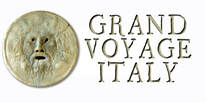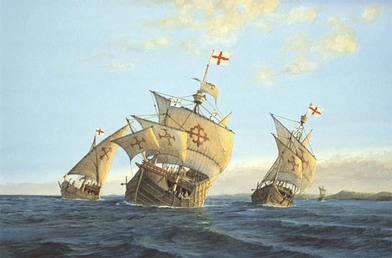 When we decided to travel to Italy, we knew it was there. Columbus had no idea that the Americas existed, but he knew--or at least, thought--that the Orient that Marco Polo had previously explored was there. He was looking for a shortcut to replace the long arduous journey through the Silk Trade Route to the Orient. It's been 523 years since he "sailed the ocean blue, in fourteen hundred and ninety-two" as we learned in school. Most people today think that people in the 15th century thought the Earth was flat, but in fact from the time of Aristotle it was well understood that our planet was a sphere. The ancient Greek mathematician Ptolemy proved that the Earth was a sphere and within a few hundred years of his death, other mathematicians and ancient astronomers even calculated the size of the Earth's circumference to near precision. Columbus and his advisers were confused by the various methods of measurement used in the ancient calculations and got the size wrong... leading to his belief that the Orient was closer than it really was--in a westward direction across the sea. He had no idea that there was a couple of continents in between Europe and China. Cristoforo was not born on born October 31, 1451... no one really knows the exact place or date of his birth. One respected historian puts his birth somewhere between August and October, 1451 in Genoa. Some other theories put the range of his birth year from 1436 to 1455! With such extremes, Columbus could have started out on his Voyage to the New World as young as 37 or as old as 56. In a time when most people died early from disease, Columbus living into his seventies is unlikely. This is one reason why most historians consider 1551 to be his birth date. Where he was born is also debated. Genoa is considered to be where he was born, but exactly what town? His father, Domenico was a wool weaver who worked in Genoa and Savona. As many people in modern day Italy, he had a couple of of ways to make a living... his second was that of a cheese monger, with young Cristoforo working as his apprentice. His mother Susanna Fontanarossa also gave birth to other sons... Bartolomeo, Giovanni Pellegrino, and Giacomo, and a daughter, Bianchinetta. Bartolomeo worked in a cartography workshop in Lisbon--along with Cristoforo--for at least part of his life. Columbus as a young boy and man was in awe of the sea. He read everything he could about the sea and being a mariner. He eventually learned to sail himself on small vessels in and around Europe. He became fairly talented, especially at navigating and map-making at 25 he and his brother worked as cartographers in Lisbon, Portugal. In 1480s he sailed and explored Africa and learned many things that would help him on his later explorations. For instance, he learned how various large seeds and plants would was up on the shores of Spain and Africa--species that were unknown to botanists. They had to be coming from somewhere, he thought. In the 1480s he presented his ideas to King John of Portugal. Just after this, Bartolomeu Dias returned to Portugal with after his successful rounding of the southern tip of Africa which proved there was a new eastern sea route to the Orient. King John was no longer interested in Columbus. He rejected his proposal. Next was a presentation to King Ferdinand and Queen Isabella or Spain. At the time he offered his plan, the Spanish Inquisition was in full swing... he had better not offend anyone, or else. They didn't accept right away, but then realized that if Columbus' plan worked, they would have a chance to get ahead of their successful upstart neighbor, Portugal. He negotiated for grand titles along with 10% of the profits of the venture (which the Spanish King and Queen reneged on after his voyage, leading to years of law suits against the Crown). Columbus's Voyages were very arduous and his first excursion with the Nina, the Pinta and the Santa Maria had its own troubles. He left Spain on August 3, 1492 and sailed west. He convinced his crew that enormous wealth awaited them, but as they passed the Canary Islands all they found was a dead calm--no wind. His crew started to second think his plan. But by September 3rd the winds started to push eastward on a calm sea. Unknowingly, he had just discovered the Southern Trade Winds that would carry westward bound ships for hundreds of years into the future. The passage dragged on and the crew became restless and thought of mutiny. Columbus kept two sets of ship logs--one to appease the crew with daily reports of traveling greater distances than they had actually gone. The second log recorded the true, slower measurements. By October 10th the crew was about to explode... but luckily (for Cristoforo) land was sighted the very next day. He didn't get rich--at least not right away. He didn't find the Orient. He didn't find gold and pearls. But he did stumble onto a New World. He's not a perfect man by any means. He also enslaved thousands of the native people, bringing back hundreds to Spain (with 200 dying on the return trip), and introduced European diseases to the indigenous people his army of men came in contact with. The native population of Greater Antilles and Bahamas dropped from one million to around 500 people within 50 years of contact with Europeans. He disobeyed the Queen about her desire not to take slaves and was thrown into chains--for a while. In the end, he made four Voyages. Their immediate success can be debated, but the contribution toward bridging the New World with the Old cannot be questioned. On 20 May 1506, around the age of 54, Columbus died in Valladolid, Spain. He never set foot in Italy again, but is still thought of as one of Italy's most successful sons. An interesting side note is that none of the portraits we know of Columbus are done from life. All are painted after 1519, years after his death. Still, there are statues, stamps and money with his likeness on them... and even an asteroid that bears his name. 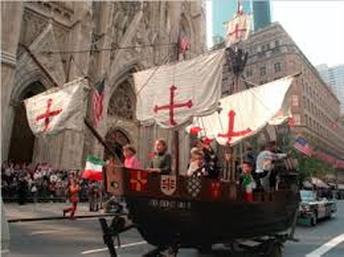 Then there are the places bearing his name: District of Columbia, Columbia University and the Columbia River. There are Columbuses in Ohio, Maryland, Missouri, South Carolina, Indiana, Georgia, Nebraska, Texas, Montana, Mississippi and Wisconsin. Of course there is the country in South America, too. And of course there are the parades in his Honor, one of the largest being held in New York City each year. And that brings us to Columbus Day. The first state to officially observe Columbus Day was Colorado in 1906. Angelo Noce, an Italian immigrant who was the founder of Colorado's first Italian newspaper, La Stella. Noce, and fellow Italian-American, Siro Mangini both worked with Colorado's first Hispanic state Sen. Casimiro Barela, to sponsor a bill proposing a Columbus Day holiday. Mangini owned a tavern named Christopher Columbus Hall, thinking that he was the only Italian Americans would not throw rocks at. Within five years of Colorado's creating the holiday, 14 other states were also celebrating Columbus Day. It took until 1934 for Columbus Day to become a federal holiday during Franklin Roosevelt's administration. The Knights of Columbus was the driving force in the creation of the holiday. In 1970 Congress declared the holiday would be on the second Monday of October. Although it's a national holiday with banks, post offices and Wall Street closing, it's still not a holiday in some states. As a kid I always wondered why "our" Italian holiday didn't mean a day off for us. Still, if we don't celebrate the man himself, we should all celebrate the bridging of Europe and the New World. If it wasn't for the years of discovery, we all wouldn't be here... --Jerry Finzi If you enjoyed this post, please share it with your friends. Grazie.
0 Comments
Your comment will be posted after it is approved.
Leave a Reply. |
Categories
All
Archive
June 2024
|


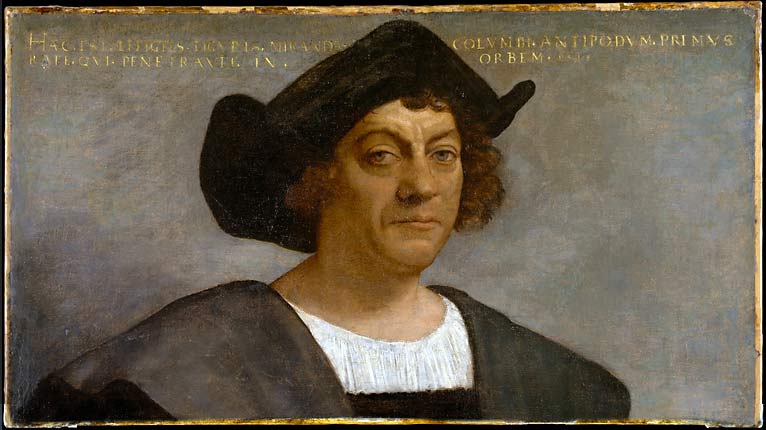
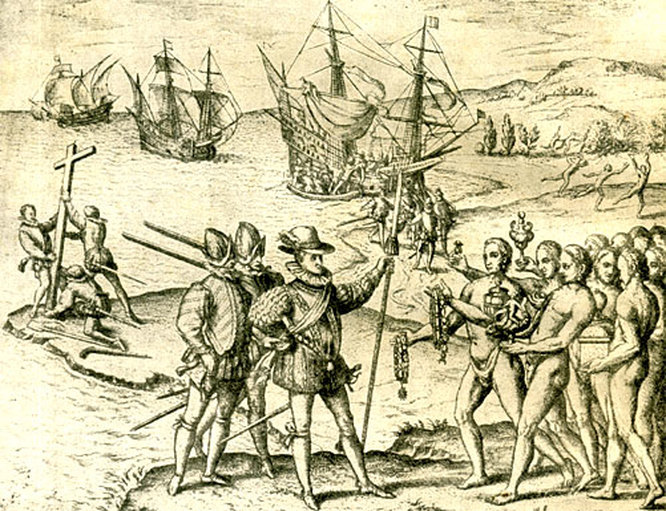
 RSS Feed
RSS Feed
